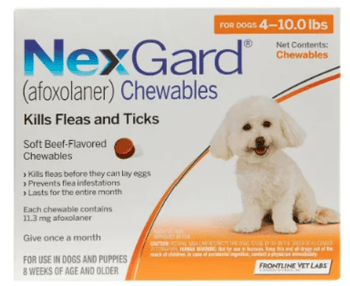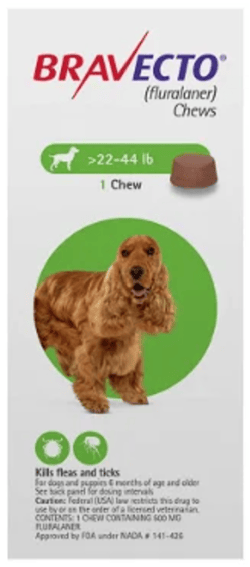Table of Contents
Fleas and ticks can be found everywhere worldwide. But although they can thrive in many different types of climates, ticks generally prefer humid and shady areas, which is why they are often found in densely wooded areas such as forests and grasslands. But dogs can sometimes get ticks just from being outside in your backyard, although it is less common than if you just took them on a hike in the woods. Ticks can attach anywhere on your dog’s body, even between their toes, and will usually appear as a brown or black lump that’s stuck to the skin. It’s important to remove ticks from your dog to help prevent the transfer of different diseases that ticks carry, but the process can be a bit tricky. The best way to remove a tick is by pulling it out in a straight, steady motion.
Fleas, on the other hand, thrive in warm, moist places. The types of fleas that can attach to your dog and cat can live anywhere outside—your shed, tall grass, sand, or debris, basically anywhere where they can find shade and humidity. The most common time for animals to get infested with fleas is in the Summer, which makes sense since your dog will likely want to escape under yard debris or into your shed as a way to beat the heat. Fleas attach to your dog’s fur and from there can get inside your home, transferring to your carpet, drapes, furniture, or plants.
Fleas on dogs are actually so common that there is a species of flea that is named the Canine flea, or Ctenocephalides canis. These little guys are not only extremely small, but they are very quick-moving as well. This makes them difficult to spot. To the human eye, canine fleas look like little dark red or brown ovals. But you’re more likely to see “flea dirt” on your dog’s skin- the flea’s feces—it looks just like regular dirt. If you see this on your dog’s fur or skin, then you’ll need to get them treatment for fleas.
Both of these tiny creatures are much more than just a nuisance for your cat or dog, they can cause serious discomfort through itching and skin irritation, spread disease, and overall make your dog sick. Also, fleas can spread throughout your home and are extremely difficult to get rid of.
This article explores flea and tick prevention for dogs, including why it is important, the potential side effects of flea and tick medication, why you shouldn’t opt for the cheapest flea and tick prevention for dogs, and more.
Importance of Flea and Tick Prevention for Dogs

Fleas and ticks are spreaders of disease and can also cause skin discomfort and irritation for your dog. In some cases, dogs can have severe allergic reactions to the bites from these insects as well. Some of the diseases that fleas and ticks can pass along to your pup can be minor, but others can cause severe and even chronic issues.
Diseases and Conditions Caused by Fleas in Dogs
Fleas can cause a lot more trouble for your pup than just some itching. These tiny insects can carry diseases and conditions a plenty, making prevention very important. The following health conditions caused by fleas in dogs are especially important to know about:
|
Disease or Condition |
Description |
|
Tapeworms |
|
|
Canine bartonellosis |
|
|
Anemia |
|
|
Contact dermatitis |
|
Diseases and Conditions Caused by Ticks in Dogs
Ticks are parasites that suck the blood from their hosts. Through this process, they can transmit dangerous bacteria to your dog’s body, potentially leading to serious conditions. The conditions that can result from a single tick bite can even result in long-term conditions and permanent damage to your pup. Some serious conditions that ticks can pass along to your dog include:
|
Disease or Condition |
Description |
|
Lyme disease |
|
|
Canine bartonellosis |
|
|
Rickettsial disease |
|
|
Canine anaplasmosis |
|
Benefits of Flea, Tick, and Heartworm Prevention for Dogs
Preventing fleas, ticks, and heartworms in dogs is crucial for maintaining their overall health and well-being.
Here are the key benefits of implementing comprehensive and safe flea and tick prevention for dogs:
1. Disease Prevention
Fleas and ticks carry a wide range of diseases that cause serious issues in your pup, including bartonellosis, tapeworms, Lyme disease, and heartworms. These diseases can result in serious and lifelong issues for your pup, with heartworm especially being a potentially fatal illness. Flea and tick prevention for dogs helps reduce the chances that your dog will become infected with one of these illnesses.
2. Prevention of Secondary Infections
Scratching and biting due to flea infestations can lead to open sores and skin infections. Tick bites may also cause localized infections. Prevention helps avoid these secondary health issues.
3. Cost Savings
Let’s face it: vet visits and treatments are costly. Flea and tick prevention for dogs is more cost-effective than treating the diseases these parasites can cause. Veterinary bills for treating conditions like heartworm disease or tick-borne illnesses can be significant, making prevention a wise investment.
4. Peace of Mind
Knowing that your dog is protected against fleas, ticks, and heartworms provides peace of mind for pet owners. It allows them to focus on enjoying their time with their furry companions without constant worry about potential health threats.
5. Supports a Comprehensive Health Care Plan
Including flea and tick prevention in a dog's overall healthcare routine is a proactive approach to maintaining their health, preventing diseases, and ensuring a longer and healthier life.
Types of Tick and Flea Prevention for Dogs
There are a variety of different types of tick and flea prevention for dogs that you can use. Most double as treatments, including:
- A Flea and tick collar is a literal collar that is placed around your dog’s neck that contains flea and tick-repellent ingredients that are continuously spread from the collar onto your dog’s skin and fur to provide lasting protection. A flea and tick collar can last up to 8 months in some cases and can be worn continuously.
- Topical flea products are used in a “spot on” treatment that is placed between your dog’s shoulder blades where they can’t lick it off. Some topical flea products repel fleas and ticks as well as kill them.
- Oral flea products are pills or capsules that are given to your dog that kill fleas and ticks once they bite your dog but don’t kill existing larvae or eggs. For this reason, oral flea products are often used in conjunction with topical treatment if your dog actually has fleas or ticks. Oral flea products can start working in as little as 30 minutes from the first dose.
Potential Side Effects of Flea Tick and Heartworm Prevention for Dogs

Flea, tick, and heartworm prevention products for dogs are generally safe when used according to the manufacturer's instructions and under the guidance of a veterinarian. However, like any medication or treatment, there can be potential side effects. It's important to be aware of these side effects and consult with a veterinarian if you observe any unusual reactions in your dog.
Common potential side effects include:
- Skin irritation: Topical treatments such as spot-on treatments or even collars (as they release ingredients onto your dog’s body to stop fleas and ticks) may cause mild skin irritation. This might go away over time as your dog gets used to flea and tick prevention. However, in some rare cases, a dog may have a severe allergic reaction.
- Gastrointestinal upset: Some dogs may experience mild digestive upset, including nausea, vomiting, or diarrhea, after taking oral flea and tick prevention for dogs, including chewable tablets.
- Neurological symptoms: In rare cases, certain flea and tick prevention products, especially those with pyrethrin/pyrethroid ingredients, may cause poisoning. Topical flea and tick spot-treatment medications often have high concentrations of pyrethrin/ pyrethroids and are often used on dogs without causing any problems. In fact, these ingredients are often found in insect sprays, foggers, and granular insecticide products, so your dog may already be exposed to these ingredients without issue. However, poisoning is something that can happen, even though it’s rare. Signs include excessive drooling, gagging or hacking, vomiting, lack of appetite, agitation, and neurological symptoms such as tremors, twitching, or seizures.
- Lethargy: Some dogs may exhibit temporary lethargy or reduced activity levels after receiving certain preventive medications. This is usually a mild effect that goes away after a short time.
- Behavioural changes: Dogs may display changes in behavior, such as restlessness or increased sensitivity, in response to certain flea and tick prevention medications. These effects are generally temporary.
- Changes in drinking and urination: Some dogs may experience changes in drinking or urination patterns as a result of certain medications. If these changes persist, it's important to consult with a veterinarian.
Important Note About Flea and Tick Prevention for Dogs with Isoxazoline
Isoxazolines are a class of synthetic chemicals that are sometimes used in flea and tick prevention for dogs, as they are effective in killing these parasitic insects.
Products containing these chemicals are approved by the U.S. Food and Drug Administration (FDA), as well as Health Canada, but in 2018 the FDA released a fact sheet alerting pet owners of potential adverse neurological effects in dogs and cats that have used this medication.
Some key information from the fact sheet is as follows:
- Flea and tick prevention for dogs that contain chemicals in the isoxazoline class are considered safe and effective for dogs and cats, but pet owners are encouraged to speak with their veterinarian so they can review the medical history of the animal and weigh the pros and cons of the medication.
- Adverse effects can still occur in dogs and cats that have taken the tick and flea prevention medication before without issues.
- There is a wide range of tick and flea prevention for dogs available on the market. Discuss your options with your veterinarian before committing to a specific product.
Given the fact that a flea or tick infestation can cause serious health problems for your pup, it’s always a good idea to invest in safe flea and tick prevention for dogs. Serious diseases and conditions like Lyme disease can result in lifelong complications for your furry friend and in some cases can even be passed to humans.
Talking with your veterinarian is of the utmost importance, as they can make an educated decision on the best flea and tick prevention for your dog based on your dog’s medical history by weighing the benefits versus the potential risks.
Best Flea and Tick Prevention for Dogs
Based on online research and reviews, below are a few of our recommendations for the best flea and tick prevention for dogs. Most of these recommendations require a prescription from a veterinarian to obtain, but some of them can be purchased online or at a pet store. As with any medication you want to give your dog, discuss the pros and cons of the medication with your veterinarian and come to the appointment armed with any questions or concerns that you may have.
Best Chewable Flea and Tick Prevention for Dogs: Nexgard Chewables

Nexgard chewable flea and tick prevention for dogs comes in a beef-flavoured tablet with special formulations for small, medium, large, and extra-large dogs. This formula is good for fleas and ticks including the Lone Star tick, Black-legged tick, American dog tick, and Brown dog tick. Puppies must be at least 8 weeks old and weigh four pounds (1.8 kg) or more. Nexgard is also a monthly treatment, so you only need to administer the medication once per month. It starts eliminating ticks and fleas within 8 hours of administration and completely kills adult fleas within 24 hours, and ticks within 48 hours.
Starts at $33.72 CAD for 3 chews. Pricing as of January 2024.
Best Oral Flea and Tick Prevention for Dogs: Bravecto

Similar to the Nexgard chews above, Bravecto provides long-lasting protection against fleas and ticks with one dose every 12 weeks. It provides protection against the Black-legged tick, American dog tick, and Brown dog tick for 12 weeks and the Lone star tick for up to 8 weeks. This medication starts working within 2 hours of administration.
$42.73 CAD per pack of 1 chew. Pricing as of January 2024.
Best Topical Flea and Tick Prevention for Dogs: Revolution For Dogs
Revolution is a more advanced parasitic monthly spot-on treatment for puppies and dogs that in addition to eliminating fleas and ticks, also helps prevent heartworm infection and helps control ear mites. It’s also a waterproof treatment that will remain effective even when exposed to water and sunlight.
Available by veterinary prescription only.
Natural Flea and Tick Prevention for Dogs
Depending on your dog’s medical history and your personal preferences, you might be looking for natural flea and tick prevention for dogs. Thankfully, there are a wide range of options that you can consider.
However, it is important to note that some natural remedies may not be effective for flea and tick prevention, and some may even do more harm than good. Think of it like old wives’ tales about putting onion slices in your socks to absorb sickness when you have a fever or wearing a necklace of garlic to ward off germs.
Natural flea and tick prevention for dogs are often derived from human ingredients that are beneficial to people, without much thought for how they may affect your dog. For example, while citronella is often relatively effective for repelling outdoor pests like mosquitoes and fleas and is harmless to people, citronella can irritate your dog’s skin and eyes and cause gastrointestinal issues if ingested. Many essential oils are also either toxic to your dog or can cause skin, eye, and gastrointestinal irritation. Tea tree, citrus, pine, pennyroyal, peppermint, sweet birch, and wintergreen are just a few examples of essential oils that you’ll want to avoid.
At the end of the day, while some all-natural flea and tick prevention for dogs may be somewhat effective, there really is no way to guarantee effectiveness since the ingredients are not regulated and scientifically tested to be effective. As a result, you should use caution when looking for all-natural flea and tick remedies for your dog, and if in doubt, consult your veterinarian to get their professional advice.
Why You Shouldn’t Opt For Cheapest Flea and Tick Prevention for Dogs

Let’s face facts, flea and tick prevention for dogs can be expensive. Prescription chewable and topicals can cost anywhere from $15–50 per dose, and many have to be given every month, adding to your pet bill. Over-the-counter treatments are usually a bit cheaper, but they are generally meant for treating a dog that already has fleas or ticks, not as a preventative measure. So really, the question is, would you rather go to a pet store and purchase a collar, over-the-counter medication, repellent, or spray and hope that it works, or would you rather go to your vet and get medication that’s guaranteed to work?
Considering that a typical vet visit can cost hundreds of dollars, it’s probably worth it to spend the extra few dollars to get safe flea and tick prevention for dogs that are going to actually work.
Safest Flea and Tick Prevention for Dogs
The safest flea and tick prevention for dogs is going to be the one you get from your veterinarian. Not only will it be guaranteed to work, but your veterinarian will analyze your dog’s past medical history and conditions to determine the safest, most effective dosage that will work for them.
Active Dogs Increase Quality of Life with Added Mobility Support
Dogs that are at an increased risk of flea and tick infestation are usually active dogs that spend a lot of time outdoors, whether it be hiking, playing outside with other dogs in a dog park, or any number of other activities. Another way that you can ensure your active pup stays happy and healthy is by incorporating joint supplements into their diet.
Dog joint supplements, specifically ones that contain glucosamine for dogs like TRI-ACTA, have been scientifically proven to help prevent and treat joint degradation, arthritis, and other joint-related conditions in dogs. It’s estimated that as many as 20% of all dogs will experience some sort of joint issue in their lifetime, but this number can be much higher depending on your dog’s breed.
TRI-ACTA contains two types of glucosamine, sulfate (essential for overall joint function and health) and HCL (a highly bioavailable form of glucosamine that is quickly absorbed and used by your dog’s body), as well as Methylsulfonylmethane (MSM, a natural anti-inflammatory) and chondroitin sulfate (helps with cartilage regeneration and repair). All of these ingredients are 100% natural and active in the supplement and backed by scientific evidence.
If your pup is already experiencing joint issues and needs a bit of extra support, TRI-ACTA H.A. includes hyaluronic acid, which thickens the synovial fluid in your dog’s joints, allowing for easier and pain-free movement.
TRI-ACTA H.A. for Pets
Our maximum strength formula is optimally designed to accelerate the formation of cartilage, minimize inflammation, expedite the healing process, and improve joint conditions.

Summary
Fleas and ticks, prevalent worldwide, can cause serious discomfort, spread diseases, and even lead to chronic health issues. Heartworms, transmitted by mosquitoes, pose a potentially fatal threat to dogs. It’s important to recognize the significance of preventative measures and explore various methods of prevention, including chewables, topicals, and oral medications.
If you’re investing in flea and tick prevention for dogs and you haven’t already been incorporating joint supplements into your dog’s diet, it’s never too late to start.
Purchase TRI-ACTA online or learn where to buy at a store near you.
Newsletter Signup
Subscribe to our newsletter to receive the latest news and exclusive offers.
.jpg?height=2000&name=Cliick_Integricare-DISPLAY-REVISEDV2%20(1).jpg)
Proactive & Therapeutic Joint Supplements
When given daily, Integricare joint supplements recover bone and joint injuries faster and help prevent mobility injuries from happening in the first place.











